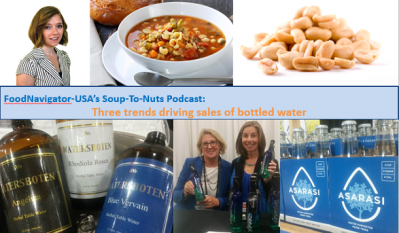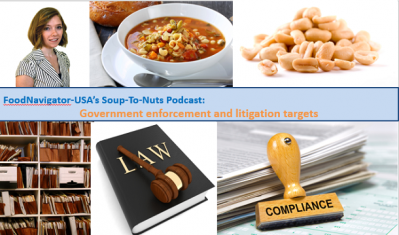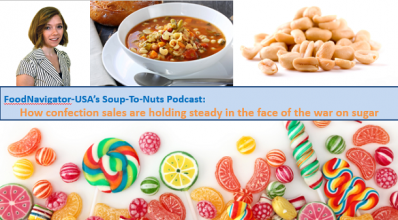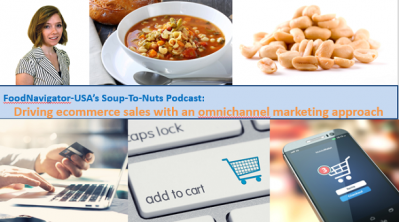Soup-To-Nuts Podcast: Emerging class action litigation targets
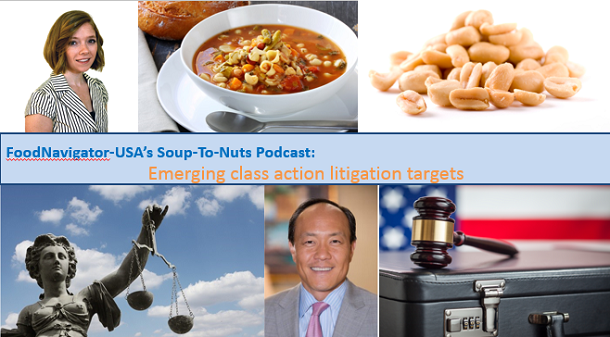
This uptick began about five years ago when attorneys began arguing that marketing claims that products were quote unquote natural created multiple avenues for consumers to potentially be misled about the quality of the product, according to the chamber. And while these cases continue, the types of claims that can land a company in court are far more broad today.
As the US Chamber Institute for Legal Reform report shows, many of the claims listed in litigation are laughable and are quickly tossed out by judges, but many others are settled at great cost to companies or litigated for years. And in these cases, the institute argues, the only real winners are the plaintiff’s attorneys who take sizable portion of any settlement, leaving the consumers the represent with only a few dollars or a voucher for a product replacement.
In this episode of FoodNavigator-USA’s Soup-To-Nuts podcast, Harold Kim, the executive vice president of legal reform initiatives at the US Chamber of Commerce Institute for Legal Reform, explains what is driving the increase in class action litigation, how these cases are built, their impact on industry and what if anything can be done to protect manufacturers.
“Since 2008, in terms of actual class action filings, which was about 20, and then if you look at 2016 you are looking at 170, and by my calculations that is 750% increase,” Kim said.
He attributes the growth to the “revenue driven model” that plaintiff’s attorneys have pursued in which they identify a case that could be misleading and then work backwards to find lead consumers who they can represent.
This model leads to big recoveries for the lawyers, but often little to nothing for the consumers, he adds.
Potential relief through litigation
In an effort to stop these alleged abuses of the system, Kim and other stakeholders are pinning a lot of hope on the Fairness in Class Action Litigation and Furthering Asbestos Claim Transparency Act of 2017, which was passed by the House in early March, but has stalled in the Senate since it was introduced on March 13.
Kim explains how the litigation, if signed by the president, could help by giving consumers greater equity in terms of the proceeds and blocking lawyers from collecting their fees until the consumers have been compensated.
The bill also would require disclosure if the lead consumer is related to one of the lawyers bringing the case as a potential conflict of interest. Likewise, it would tighten the standards for class certification, Kim said.
Top targets
Until the legislation passes, manufacturers in the food and beverage space need to stay on their toes to stay out of the way of the evolving types of allegations brought in class action cases.
Kim explained that the vast bulk of activity currently focuses on products marketed as natural, but there are also significant cases dealing with slack fill, evaporated cane juice, handmade claims and many more.
Other targets mentioned in the institute’s report include health related claims for any products with added-sugars, products with trace amounts of unclaimed ingredients, trans fats or partially hydrogenated oils and claims related to the origin of the product.
Snacks are most targeted
As for what types of products are most at risk, Kim says basically anything and everything in the grocery store is fertile ground for plaintiff’s lawyers.
“Plaintiffs lawyers are probably spending a lot of time in the grocery store and maybe not to get groceries, but to actually look at potential claims and looking at the products,” he said.
That said, the institute found snack foods were the target in 22% of the federal and identified state class actions active in 2015 and 2016. Cheese accounted for 11%, juice 9% and energy drinks and coffee and tea accounting for 4%. After that the division is highly fragmented.
No clear end in sight
Kim also notes that he doesn’t see the litigation slowing down anytime soon – especially if the Fairness in Class Litigation legislation remains stalled or fails.
He adds that because of the whack-a-mole nature of class action litigation, manufacturers’ best defense is a good offense, which they can hone by watching where litigation is going.
